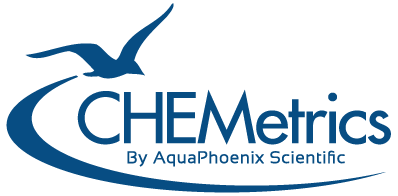Chemical Oxygen Demand (COD) Vials

What is Chemical Oxygen Demand (COD)?
Chemical Oxygen Demand (COD) is a wastewater parameter that measures the amount of a specified oxidant after it reacts with organic matter under controlled conditions. A COD test typically involves digestion of a water sample in a sealed vial with potassium dichromate and sulfuric acid at 150oC for 2 hours.
Why test for COD?
Chemical oxygen demand measurements are used to estimate water pollution levels entering and leaving wastewater treatment and industrial facilities. In the United States, treatment facilities are considered point sources, making them regulated under the Clean Water Act (CWA) which in turn sets facility specific pollutant release targets as part of the National Pollutant Discharge Elimination System (NPDES) permitting process. These permits often specify limits based on the COD chemistry method of analysis.
Additionally, there is a connection between energy use at wastewater facilities and COD. Wastewater engineers can use COD as an indicator for how much oxygen will be required to treat incoming waste streams. This has a direct impact on aeration equipment power consumption. Having an understanding of COD trends allows engineers to optimize power usage and gain control of energy costs.
About our COD Test Kits
CHEMetrics offers two dichromate reactor digestion methods for fast, easy, safe determinations of low-, mid-, and high-range COD levels in wastewater: the USEPA-accepted Method* and a mercury-free method. The products using the USEPA-accepted method contain mercuric sulfate in the reagent to eliminate chloride interferences. The mercury-free chemical oxygen demand test kit line is applicable when chloride interference is not a concern and USEPA reporting is not required.
Click here to see how our COD test kits compare to competitors.
Click on a catalog number in the tables below for more information or to purchase a COD test kit.
Instrumental Kits
| Range | Method | Kit Catalog No. | No. of Vials |
|---|---|---|---|
| 0-150 ppm (LR) USEPA-accepted | Dichromate Reactor Digestion | K-7350S* | 25 |
| 0-150 ppm (LR) USEPA-accepted | Dichromate Reactor Digestion | K-7355* | 150 |
| 0-150 ppm (LR) Mercury-free | Dichromate Reactor Digestion | K-7351S | 25 |
| 0-150 ppm (LR) Mercury-free | Dichromate Reactor Digestion | K-7356 | 150 |
| 0-1500 ppm (HR) USEPA-accepted | Dichromate Reactor Digestion | K-7360S* | 25 |
| 0-1500 ppm (HR) USEPA-accepted | Dichromate Reactor Digestion | K-7365* | 150 |
| 0-1500 ppm (HR) Mercury-free | Dichromate Reactor Digestion | K-7361S | 25 |
| 0-1500 ppm (HR) Mercury-free | Dichromate Reactor Digestion | K-7366 | 150 |
| 0-15,000 ppm (HR+) Not USEPA Approved | Dichromate Reactor Digestion | K-7370S* | 25 |
| 0-15,000 ppm (HR+) Not USEPA Approved | Dichromate Reactor Digestion | K-7375* | 98 |
| 0-15,000 ppm (HR+) Mercury-free | Dichromate Reactor Digestion | K-7371S | 25 |
| 0-15,000 ppm (HR+) Mercury-free | Dichromate Reactor Digestion | K-7376 | 98 |
Analytical Standard
| Product | Kit Catalog No. |
|---|---|
| COD Calibration Standard, 1000 ppm | A-7301 |
| COD Calibration Standard, 10,000 ppm | A-7310 |
» COD Procedure – For use when comparing COD Vials to alternative supplier
» Cross Reference to Hach® COD Products
CHEMetrics’ leakproof reagent vials contain premeasured solutions of sulfuric acid and potassium dichromate. To perform the COD determination, the analyst simply removes the Teflon-lined screw cap from the vial, adds sample to the vial, and replaces the cap. The vial is then heated for two hours at 150°C in a standard digestor block. Once digestion is completed, results are obtained using a photometer that accepts 16-mm diameter cells. CHEMetrics COD vials can be used directly in our V-2000 multi-analyte photometer, CHEMetrics single analyte COD photometers, as well as in many Hach spectrophotometers.1 Built-in Hach COD methods and calibrations can be used without the need for a new calibration. A calibration equation is included within the CHEMetrics Chemical Oxygen Demand (COD) testing kit for use with other spectrophotometers.
*Contains mercury. Dispose according to local, state or federal laws.
1 NOTE: No endorsement by Hach Company is implied or intended.

